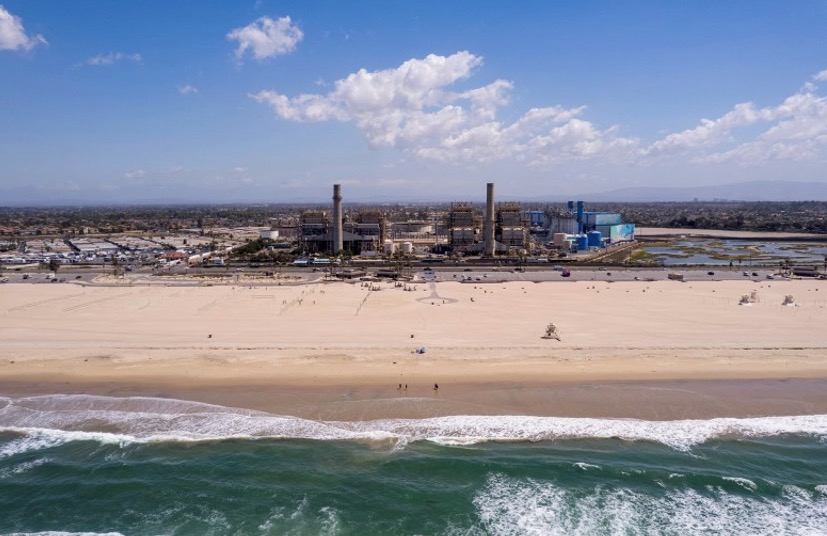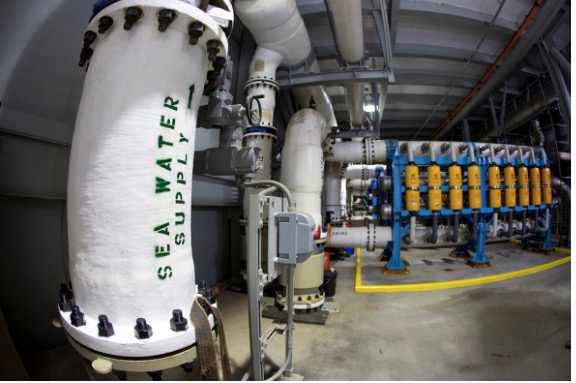CommentsDRINKABLE WATER - The California Coastal Commission tonight rejected the proposed construction of a desalination plant in Huntington Beach, sealing the controversial project’s fate after more than 20 years of debate.
The unanimous decision about the $1.4-billion plant in Huntington Beach is pivotal because it sets a high bar for the future of turning seawater into drinking water in California, which can help buffer its vulnerable water supply against drought.
The Coastal Commission staff had advised the commission to deny approval — citing, among other factors, the high cost of the water and lack of local demand for it, the risks to marine life and the possibility of flooding in the area as sea levels rise.
Executive Director Jack Ainsworth said their recommendation was not a referendum on the future of desalination in California, pointing to more optimistic prospects for another project, the proposed Doheny Desalination Facility in south Orange County’s Dana Point.
“Denial of this project does not mean that we’re setting the stage for the denial of all desal facilities or other critical infrastructures across the state,” he said. “Every project has a different set of circumstances, facts and context.”
Poseidon Water, the developer of the proposed plant, pushed back against criticism at the meeting and expressed disappointment in the decision.
“We firmly believe that this desalination project would have created a sustainable, drought-tolerant source of water for Orange County, just as it has for San Diego County,” Poseidon director of communications Jessica Jones said in an emailed statement.
Jones thanked California Gov. Gavin Newsom, who had voiced his support of the project, telling the the Bay Area News Group Editorial Board that it would be “a big mistake, a big setback” to kill it.
The plant would have sucked in nearly 107 million gallons of seawater and spit out 50 million gallons of drinkable water a day, enough to supply nearly 460,000 people in Orange County, which is home to about 3.2 million people.
Commissioners met today in a packed Costa Mesa conference room, just miles from the site, which is home to a power plant, where the project would be built. Some attendees held hand-painted signs proclaiming “Say No to Poseidon.” The sign of another attendee, wearing an inflatable green hat, declared “I am a plankton, please do not kill me!”
The public and elected officials who spoke at the hearing were divided in their support and opposition of the desalination plant. A loud cheer went up after the vote, which came almost ten hours after the meeting began.
More than 200 people had lined up to comment on the project, and public comments lasted about six hours. “It’s going to be a long day,” Commission Chair Donne Brownsey warned at the beginning of the hearing. “So everybody, just hope you brought snacks.”
Brownsey opened the meeting with a rebuke of Poseidon: The company had released a document on Coastal Commission letterhead resembling the commission’s own staff report. But instead of staff’s recommendation to deny the project, Poseidon’s version recommended approval.
“This was not a good decision by the applicant to put it on Coastal Commission letterhead, because it did cause some confusion among members of the public and the press,” Brownsey said. “We have not seen this before. We hope this is the last time we see it.”
DJ Moore of the law firm Latham & Watkins, speaking on behalf of Poseidon, later apologized “if the alternative staff report we submitted caused any confusion … Our intent was only to show the commission the findings that could support a project approval.”
Brownsey shushed the audience’s laughter, and issued a reminder about decorum — one of many such admonitions to a restive audience.
The Huntington Beach facility wouldn’t have been the first desalination plant constructed in California. Poseidon also developed one in Carlsbad that supplies water to San Diego County. Santa Barbara also has one. Other inland plants clean up brackish groundwater stores in Orange County.
The approval process for the Huntington Beach plant, though, was particularly drawn out and contentious. “There are still many key details about the project that are not developed, which has made it incredibly difficult to review,” said Kate Huckelbridge, a Coastal Commission deputy director.
The staff report points to San Diego County water costs from the Carlsbad plant that have tripled since Poseidon’s early estimates.
It’s unclear, however, whose water bills might be affected by the Huntington Beach project, because “Poseidon has not yet secured a buyer for the water and does not know where its water would be delivered,” the staff report said.
Though Orange County Water District signed a non-binding term sheet with the company, “any eventual purchase is contingent on Poseidon being able to obtain hundreds of millions of dollars in subsidies from Metropolitan Water District and that Poseidon provide specific expected costs for its water, among other things. (Orange County Water District) also had not identified an immediate need for much of the water…,” the staff report said.
Multiple Orange County Water District board members voiced their support of the project at the hearing, with board member Cathy Green saying, “We need this water and we need it now.” Board member Kelly Rowe, however, said “it fundamentally does not make sense.”
Coastal Commission staff also sounded the alarm about the millions of gallons of larval fish that would be sucked into the plant, and the millions of other marine creatures killed by the water pumped back into the ocean.
“The project would kill marine life in about 275 million gallons of seawater per day, which is about 100 billion gallons of seawater each year,” said Tom Luster, an environmental scientist with the commission. “If this type and scale of impact were to happen on land, it would be highly visible and alarming.”
Though staff described many of these concerns in 2013, Huckelbridge said “Poseidon has not been willing to offer more than a cursory description” of how it would reduce those ecological impacts. Staff said construction of projects to offset the impacts of the Carlsbad facility, which opened in 2015, still have not begun.
Poseidon’s representatives addressed the staff’s concerns point-by-point, emphasizing the need for desalination in a drought-prone state.
They cited building plans intended to reduce threats to the facility and its pipes, including from earthquakes, tsunamis and rising sea levels. And they contested staff’s criticism of their environmental restoration efforts, saying they propose to restore about 150 acres of degraded wetlands in Long Beach, among other projects.

The proposed $1.5 billion water desalination plant was in an area known for its coastal wetlands. REUTERS/Mike Blake
“The project has undergone 20 years of environmental planning. It’s certainly the most extensively studied desal facility in the state, if not the world, and it has been approved by multiple agencies including the State Lands Commission, including the Regional Water Quality Control Board,” Moore said
“Desalination provides a drought-proof local supply that the state recognizes is important to combat climate change,” he said.
Moore said the water could buffer the effects of drought on lower-income communities.
“History shows that disadvantaged communities are affected worse by drought, both with lower water allocations and with greater cost impacts from penalties,” he said.
The mayor of Carlsbad and a representative of the San Diego County Water Authority extolled the company’s Carlsbad facility, the mayor calling it “drought-proof and locally controlled.”
“The local community supports desal in Huntington Beach,” said Latham & Watkins’ Jennifer Roy, speaking on behalf of Poseidon, about an hour and 45 minutes into the hearing.
The audience responded with a loud “no, no!”
“Excuse me, I’m not going to caution again,” Brownsey said. “Please, do not disrupt the hearing.”
Nancy Vogel, deputy secretary for water at the California Natural Resources Agency, spoke up to defend desalination “where it is cost effective and environmentally appropriate,” but she did not say anything in direct support of the project.
“We do expect all regions of the state to continue diversifying their water supplies with focus and urgency including considering desalination along the coast,” she said.
Commissioners discussed the proposal for nearly two hours, with the unanimous consensus slowly emerging that the proposal for this particular plant — but not desalination itself — had fallen short.
“I wish that I didn’t have to take this vote today. I’m not opposed to desalination. Full stop,” said commissioner Meagan Harmon, a Santa Barbara City Councilmember. She pointed to the desalination plant in Santa Barbara as a critical part of the city’s supply. But she said desalination has to be cost-effective and environmentally sound. “And I don’t think this project and the mitigation package as it’s currently proposed, meets those standards.”
Brownsey, the commission chair, added that California “must have a statewide plan” and ground rules for desalination so the expectations for businesses and governments are clear.
“Time is running out,” she said. “We have major water problems in California, and it’s going to take every tool in the toolbox, including intelligent desalination to address those.”
(Rachel Becker is a reporter with a background in scientific research. Rachel now covers California’s complex water challenges and water policy issues for CalMatters. In 2021 she won first place for Outstanding Beat Reporting from the Society of Environmental Journalists. This story was featured in CalMatters.)
